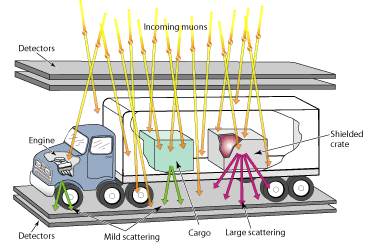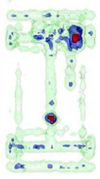Cosmic Insight into Pyramids, Volcanoes and Nuclear Contraband

WASHINGTON D.C. - Just as dental X-rays find cavities in your teeth, a group of researchers plan to use a natural form of radiation, called cosmic ray muons, to search for cavities in a 2,000-year-old pyramid.
The technique might also be used to spot contraband nuclear material and monitor volcanoes.
The muons, which are like heavy electrons, form like a shower when a cosmic ray crashes into an air molecule in the upper atmosphere. About 1,000 muons pass through a square foot on the Earth's surface every minute.
The average energy of these particles is about a million times greater than that of the X-ray photons used in dental exams. This higher energy lets the muons pass through thick materials.
"X-rays are good for going through flesh, but not through rock or metal," said Rick Chartrand of Los Alamos National Laboratory. Cosmic ray muons, on the other hand, can pierce six feet of lead with only a slight change to their speed and direction.
Scientists can detect these slight changes to see inside a pyramid, or even a volcano - possibly predicting an eruption.
Always on
Sign up for the Live Science daily newsletter now
Get the world’s most fascinating discoveries delivered straight to your inbox.
"We know the distribution of angles and energies at which the muons arrive," Chartrand said. "And they are always there, so you don't have to go to the trouble of generating a source."
On Saturday, Chartrand organized a session on the promise of muon radiography at the Annual Meeting of the American Association for the Advancement of Science, held here. Chartrand and his colleagues are devising a way to place muon detectors at ports to search for illicit nuclear material that might be smuggled in cargo containers.
The path of a muon through a material depends on density. The amount of deviation, or scattering, will be indicative of an empty tomb, a lava-filled crater, or a piece of uranium.
The idea to use cosmic ray muons for practical purposes goes back to the 1960s, when the Nobel Prize-winning physicist, Luis Alvarez, searched for hidden chambers in the Chephren Pyramid of Giza in Egypt. He didn't find any.
Hidden burial
But following in Alvarez's footsteps, Arturo Menchaca-Rocha of the National Autonomous University of Mexico and his colleagues plan to use cosmic ray muons to scan the Pyramid of the Sun in Teotihuacan, Mexico.
This 215-foot tall pyramid was revered by the Aztecs of the 13th Century, who arrived 600 years after the ancient city of Teotihuacan was completely abandoned.
"No one knows why the pyramid was built," said Arturo Menchaca-Rocha of the National Autonomous University of Mexico. "There might be an important person buried there."
A nearby structure called the Pyramid of the Moon is known to have been a grisly burial site, but none of the same tomb markers have yet been found in the Pyramid of the Sun.
Menchaca-Rocha's team plans to place a small muon detector in a tunnel 26 feet below the pyramid's base. The tunnel was discovered in the 1970s and is believed to be older than the pyramid itself.
The scientists expect that after a year of observation they will be able to say whether there are any tunnels or rooms in the largely soil-filled pyramid.
Magma movement
A similar sort of experiment is studying the magma activity in volcanoes. The detectors in this case are placed around the mountain to measure muons that travel horizontally as much as half a mile through the volcano.
Kanetada Nagamine of the KEK Muon Science Laboratory in Japan and his colleagues have measured the amount of molten rock within the craters of two active volcanoes: Mt. Asama and Mt. West Iwate, both in Japan.
If levels of the molten rock rise, that could mean an eruption is imminent. Nagamine said an expanded version of this monitoring system could one day go on all potentially active volcanoes in the world, as a way to provide better warnings of disasters.
Nuclear threat
The technology might also deter the smuggling of nuclear materials into the country by ship or by truck.
Using detectors above and below a cargo container or truck, Chartrand and his collaborators have shown that they can detect shielded nuclear material in 60 seconds, with about a three percent error rate.
What the researchers count on is the fact that a chunk of uranium or plutonium will most likely be heavily shielded with something dense, like lead or gold. Both the nuclear material and the shielding will deflect many of the incoming muons, creating a distinct pattern on screens that would alert authorities.
"The more the nuclear material is shielded, the easier it is to detect," Chartrand said.
If a the radioactive material is not shielded, it should be easily spotted with Geiger counters or gamma ray detectors - devices which the researchers said should accompany any muon-detecting system.
"Shielding is a complicated thing, so you want to make sure the smugglers have to work hard," said Chris Morris, a co-worker of Chartrand.
How it Works
1. A cosmic ray (yellow) hits the upper atmosphere and produces a shower of other particles (green). Some of these (mostly pions) decay into muons (red). Only a small fraction of the muons reaches the earth's surface before decaying. At sea level, one muon goes through an area the size of your fingernail about every minute.
2. Muons coming from the sky are detected above and below a truck. They are scattered more by uranium and plutonium than by steel or water.


LiveScience Staff SOURCES: LANL and Terry Anderson, Stanford Linear Accelerator Center (cosmic ray image)











